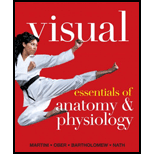
Visual Essentials of Anatomy &Physiology
1st Edition
ISBN: 9780321780775
Author: Martini, Frederic
Publisher: Prentice Hall
expand_more
expand_more
format_list_bulleted
Concept explainers
Question
Chapter 6.3, Problem 2.3R
Summary Introduction
To compare: Plantar flexion and dorsiflexion.
Introduction: The movements of the body are described using certain anatomical terms. The terms used to describe the movement is based on the anatomical position of the joints. The various types of body movements include abduction, extension, flexion, and adduction. The ankle joint is responsible for movements like dorsiflexion and plantar flexion.
Expert Solution & Answer
Want to see the full answer?
Check out a sample textbook solution
Chapter 6 Solutions
Visual Essentials of Anatomy &Physiology
Ch. 6.1 - Describe the Organization of skeletal muscle at...Ch. 6.1 - Prob. 2LOCh. 6.1 - Prob. 3LOCh. 6.1 - Prob. 4LOCh. 6.1 - Prob. 5LOCh. 6.1 - Prob. 1.1RCh. 6.1 - Prob. 1.2RCh. 6.1 - Prob. 1.3RCh. 6.1 - In a sarcomere, what is the zone of overlap?
Ch. 6.1 - Describe the components of thin and thick...
Ch. 6.1 - Prob. 2.3RCh. 6.1 - Prob. 3.1RCh. 6.1 - Prob. 3.2RCh. 6.1 - Prob. 3.3RCh. 6.1 - Prob. 4.1RCh. 6.1 - Prob. 4.2RCh. 6.1 - Prob. 4.3RCh. 6.1 - Prob. 5.1RCh. 6.1 - Prob. 5.2RCh. 6.1 - What triggers myosin reactivation?
Ch. 6.1 - Prob. 1.1SRCh. 6.1 - Prob. 1.2SRCh. 6.1 - Prob. 1.3SRCh. 6.1 - Prob. 1.4SRCh. 6.1 - Prob. 1.5SRCh. 6.1 - Prob. 1.6SRCh. 6.1 - Prob. 1.7SRCh. 6.1 - Prob. 1.8SRCh. 6.1 - Prob. 1.9SRCh. 6.1 - Prob. 2.1SRCh. 6.1 - Label the structures in this diagram of adjacent...Ch. 6.1 - Prob. 2.3SRCh. 6.1 - Prob. 2.4SRCh. 6.1 - Prob. 2.5SRCh. 6.1 - Prob. 2.6SRCh. 6.1 - Prob. 2.7SRCh. 6.1 - Prob. 2.8SRCh. 6.1 - Prob. 2.9SRCh. 6.1 - Vocabulary
In the space provided, write the...Ch. 6.1 - Prob. 3.2SRCh. 6.2 - Describe the mechanism responsible for producing...Ch. 6.2 - Prob. 2LOCh. 6.2 - Prob. 3LOCh. 6.2 - Prob. 4LOCh. 6.2 - Prob. 5LOCh. 6.2 - Prob. 1.1RCh. 6.2 - Prob. 1.2RCh. 6.2 - Prob. 1.3RCh. 6.2 - Prob. 2.1RCh. 6.2 - Prob. 2.2RCh. 6.2 - Prob. 2.3RCh. 6.2 - Prob. 3.1RCh. 6.2 - Prob. 3.2RCh. 6.2 - Prob. 3.3RCh. 6.2 - Prob. 4.1RCh. 6.2 - Prob. 4.2RCh. 6.2 - Prob. 4.3RCh. 6.2 - Prob. 5.1RCh. 6.2 - Prob. 5.2RCh. 6.2 - Prob. 5.3RCh. 6.2 - Prob. 1.1SRCh. 6.2 - Prob. 1.2SRCh. 6.2 - Prob. 1.3SRCh. 6.2 - Prob. 1.4SRCh. 6.2 - Prob. 1.5SRCh. 6.2 - Prob. 1.6SRCh. 6.2 - Prob. 1.7SRCh. 6.2 - Prob. 1.8SRCh. 6.2 - Prob. 2.1SRCh. 6.2 - Prob. 2.2SRCh. 6.2 - Prob. 2.3SRCh. 6.2 - Prob. 2.4SRCh. 6.2 - Prob. 2.5SRCh. 6.2 - Prob. 2.6SRCh. 6.2 - Explain what happens to the lactate produced...Ch. 6.2 - Some clinical conditions of the muscular system...Ch. 6.2 - Prob. 3.3SRCh. 6.3 - Explain how the name of a muscle can help identify...Ch. 6.3 - Prob. 2LOCh. 6.3 - Prob. 3LOCh. 6.3 - Prob. 4LOCh. 6.3 - Identify the main muscles of the head and neck,...Ch. 6.3 - Prob. 6LOCh. 6.3 - Prob. 7LOCh. 6.3 - Prob. 8LOCh. 6.3 - Prob. 9LOCh. 6.3 - Prob. 10LOCh. 6.3 - Prob. 11LOCh. 6.3 - Prob. 1.1RCh. 6.3 - Prob. 1.2RCh. 6.3 - Prob. 1.3RCh. 6.3 - Prob. 2.1RCh. 6.3 - Prob. 2.2RCh. 6.3 - Prob. 2.3RCh. 6.3 - Prob. 3.1RCh. 6.3 - Prob. 3.2RCh. 6.3 - What hand movements occur when wriggling into...Ch. 6.3 - Prob. 4.1RCh. 6.3 - Prob. 4.2RCh. 6.3 - Prob. 4.3RCh. 6.3 - Prob. 5.1RCh. 6.3 - Prob. 5.2RCh. 6.3 - Prob. 5.3RCh. 6.3 - Prob. 6.1RCh. 6.3 - Prob. 6.2RCh. 6.3 - Prob. 6.3RCh. 6.3 - Prob. 7.1RCh. 6.3 - Prob. 7.2RCh. 6.3 - Prob. 7.3RCh. 6.3 - Prob. 8.1RCh. 6.3 - Prob. 8.2RCh. 6.3 - Prob. 8.3RCh. 6.3 - Prob. 9.1RCh. 6.3 - Prob. 9.2RCh. 6.3 - Prob. 9.3RCh. 6.3 - Prob. 10.1RCh. 6.3 - Prob. 10.2RCh. 6.3 - Prob. 10.3RCh. 6.3 - Prob. 11.1RCh. 6.3 - Prob. 11.2RCh. 6.3 - How would a torn calcaneal tendon affect movement...Ch. 6.3 - Prob. 1.1SRCh. 6.3 - Prob. 1.2SRCh. 6.3 - Prob. 1.3SRCh. 6.3 - Prob. 1.4SRCh. 6.3 - Prob. 1.5SRCh. 6.3 - Prob. 1.6SRCh. 6.3 - Prob. 1.7SRCh. 6.3 - Prob. 1.8SRCh. 6.3 - Prob. 2.1SRCh. 6.3 - Prob. 2.2SRCh. 6.3 - Prob. 2.3SRCh. 6.3 - Prob. 2.4SRCh. 6.3 - Prob. 2.5SRCh. 6.3 - Prob. 2.6SRCh. 6.3 - Prob. 2.7SRCh. 6.3 - Prob. 2.8SRCh. 6.3 - Prob. 2.9SRCh. 6.3 - Label each of the indicated muscles that move the...Ch. 6.3 - Prob. 3.2SRCh. 6.3 - Prob. 3.3SRCh. 6.3 - Prob. 3.4SRCh. 6.3 - Prob. 3.5SRCh. 6.3 - Prob. 3.6SRCh. 6.3 - Prob. 3.7SRCh. 6.3 - Prob. 3.8SRCh. 6 - Prob. 1CRQCh. 6 - Prob. 2CRQCh. 6 - Prob. 3CRQCh. 6 - Prob. 4CRQCh. 6 - Prob. 5CRQ
Knowledge Booster
Learn more about
Need a deep-dive on the concept behind this application? Look no further. Learn more about this topic, biology and related others by exploring similar questions and additional content below.GCSE PE - ANTAGONISTIC MUSCLE ACTION - Anatomy and Physiology (Skeletal and Muscular System - 1.5); Author: igpe_complete;https://www.youtube.com/watch?v=6hm_9jQRoO4;License: Standard Youtube License